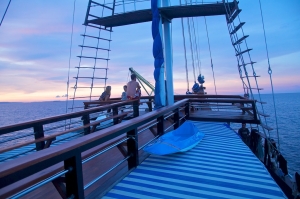In November, 2010 we took a break from RVing and traveled to the Raja Ampat area of Indonesia, formally known as Irian Jaya, to go scuba diving in the most marine bio-diverse area of the world. Raja Ampat, which means Four Kings, is an archipelago consisting of four main islands; Misool, Salawait, Batanta and Waigeoover and over 1500 small islands, cays and shoals. Getting to the remote areas of Indonesia is not easy and requires you to book flights with one or more Indonesia domestic airlines, but the diving is so spectacular, it makes the major hassle of getting to the remote areas of Indonesia worth all the issues of dealing with dirty, smelly airports, late airplanes, and filthy, filthy restrooms, including the ones on the planes. I’ve been to Sipadan when it was spectacular back in 1996 and to Wakatobi in 2004 and again in 2007, but the reefs of Raja Ampat are even more beautiful with more fish than I’ve ever seen before!
We originally booked our trip on the Archipelago Adventurer II (AAII) and were really looking forward to our trip on the highly acclaimed Indonesian liveaboard, but a few weeks before our trip, the AAII ran aground and we ended up on a substitute boat called the Sea Safari III (SSIII) and fortunately with most of the crew from the AAII. The SSIII was old, but the world class diving, AAII’s delicious food, AAII’s fantastic dive crew and great tender boats made up for the poor accommodations on the boat. For example on day two of our trip, a pipe burst and we lost a third of our non-potable water, plus had no hot water for the remainder of the trip, which meant cold showers after diving each day. The rest of the trip was without any additional major incidents, for which we are very, very thankful. We spent eleven nights on the boat and we traveled from Ambon to Sorong, covering both the northern and southern Raja Ampat areas.
The southern area of Raja Ampat is known for its beautiful soft corals in every pastel color imaginable, along with massive, colorful sponges and extremely large beautiful sea fans; some spanning more than nine feet across. The northern area of Raja Ampat is known for its hard corals and large schools of fish. In both areas, the reefs were very healthy and absolutely gorgeous and the number of fish on each dive was absolutely incredible. We saw our first wobbegong shark and also a blue-ringed octopus and several nudibranchs we hadn’t seen before. Of course on every dive we were looking for the infamous pygmy seahorse, some so small a magnifying glass is needed to see them.
The currents in Raja Ampat were the worse we’ve ever encountered, so on all days but the first full day, we skipped the fourth dive. The last few dives near Kri Island, the currents were ripping so we used reef hooks and hooked onto a dead piece of coral on the reef to watch the large schools of trevally, barracuda, bat fish, a few sharks and other schools of fish swim by.
For our last dive of the trip we repeated Cape Kri and the current was so strong, as soon as we jumped into the water we were swept off the reef, so we all went back up, took off our equipment, climbed back onto our tender boat, geared back up and back-rolled again into the water. We descended as fast as we could then hooked on a dead piece of coral with our reef hooks and watched the spectacular fish action, but when we loosened our reef hooks, we were swept a kilometer away to the other side of the island. The current died down and we continued to enjoy the dive, which included seeing a couple of black tip reef sharks. Several minutes later, the current started up again, but this time it was a ripping down current, so we decided it was time to end our twenty-ninth and last dive of the trip. I’ve been to Wakatobi twice, once in 2004 and in 2007, to Fiji in 2002, the Philippines in 2009 and to Sipadan back in 1996 and Raja Ampat beats all of them hands down for spectacular reefs and large numbers of fish.
Unfortunately, a few days after returning to the US, we found out the Sea Safari III ran aground four days after we got off the boat when the SSIII captain entered the wrong info into the auto pilot and hit an island around 1AM going eight knots. All passengers and crew got off safely, but the boat was looted the next night, then mysteriously caught on fire and sank. Both incidents were too much for Archipelago Fleets, especially with the Adventurer II being unrepairable, so Archipelago Fleets closed down on Dec 20th. A very sad time for all involved.
The diving was so fantastic in Raja Ampat, I’d like to return again within the next few years, but this time in better shape so we can do all the dives and with a much smaller underwater camera system. I’m not sure if it will be on a live-aboard, although if you stay at a resort on land, malaria prevention treatment is necessary.
Click on the route map photo to see our photos of Raja Amput, both above water and below water.


